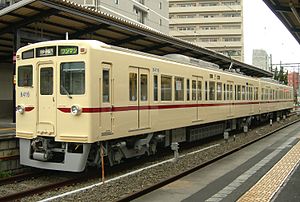You can help expand this article with text translated from the corresponding article in Japanese. (December 2020) Click [show] for important translation instructions.
|
This article needs additional citations for verification. (March 2008) |
| Keio 6000 series | |
|---|---|
 Set 6416 in November 2009 | |
| In service | 1972–2011 |
| Entered service | 23 May 1972 |
| Number built | 304 vehicles |
| Number in service | None |
| Number preserved | 1 vehicle, 2 cab ends |
| Number scrapped | 301 vehicles |
| Formation | 2/3/4/5/6/8 cars per trainset |
| Operators | Keio Corporation |
| Lines served | |
| Specifications | |
| Car body construction | Steel |
| Car length | 20 m (65 ft 7 in) |
| Maximum speed | 110 km/h (68 mph) |
| Traction system | |
| Acceleration | 2.5 km/(h⋅s) (1.6 mph/s) (3.3 km/(h⋅s) (2.1 mph/s) for 6030 series on Shinjuku Line) |
| Deceleration | 4.0 km/(h⋅s) (2.5 mph/s) 4.5 km/(h⋅s) (2.8 mph/s) (emergency) |
| Electric system(s) | 1,500 V DC |
| Current collector(s) | Overhead |
| Multiple working | 9000 series, 7000 series |
| Track gauge | 1,372 mm (4 ft 6 in) |
The Keio 6000 series (京王6000系, Keiō 6000-kei) was an electric multiple unit (EMU) train type in Japan, operated by Keio Corporation on its suburban Tokyo commuter rail network between 1972 and 2011. It was the first rolling stock in Keio's history with 20 m (65 ft 7 in) long cars with four pairs of doors per car side. Sets were refurbished from 1986 to extend their service life.
A four-car formation was used on the Keio Dobutsuen Line as a wanman driver-only-operated shuttle service.